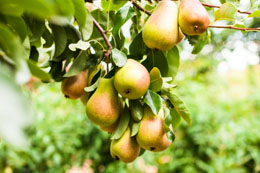Although pear trees are one of the easiest to care for and maintain, many people find it difficult to prune them. Hence, the article provides information about pruning pear trees.

Pear is a fruit bearing tree that belong to the genus
Pyrus and family
Rosaceae. It is a perennial tree that bears edible, pomaceous fruits. Its floral structure is similar to the apple tree, which also belongs to the same family
Rosaceae. It is an easy-to-grow tree that grows well in well-drained fertile soil, and requires full sunlight. Late winter or early spring is the best time to plant the pear tree. Being less prone to pest and disease, it lives longer than an apple tree. Though the tree has a high tolerance to dryness, it is recommended to water it regularly for a better yield.
When it comes to pruning fruit trees, most of us get stuck about deciding which is the right time and method of pruning. Though many of us think that pruning an apple or pear tree is more or less the same, the truth is that there are certain parameters in which both the trees vary that need to be considered. Unlike apple trees, pear trees bear their fruits closer to the main branches. Also, since their branches are not as strong as that of the apple trees, one shouldn't hurry in pruning and should wait for the most appropriate time. Hence, in the coming sections, we will learn when and how to prune a pear.
When to Prune
Though the best time to prune a pear is in winter when the tree is dormant, you can also consider pruning it in the late summer if the wood has hardened and the tree has completed growing for the year around this time. You can also prune it periodically when it is young, as this will keep the tree from growing too tall and will make it easier to reach the fruit on the upper branches. For optimum yield, maintain a regular pruning schedule, as this will provide the tree a healthy growing environment.
How to Prune
Pruning a pear tree is not as difficult as it seems to be. Do not hurry, and avoid doing any major pruning before the spring. However, if you notice any broken or diseased branches, cut or remove them during any time of the year. Use proper shears and keep your cuts clean. Avoid cutting very close to the main branches or the trunk. In case you thinned the tree in the previous year, wait for a couple of years before thinning or pruning it again.
Remove the shoots that spring up around the tree and also trim the branches that are not pointing upwards. Also, prune or trim the branches that are very close to each other. It is better to trim off any part of the tree that doesn't receive enough sunlight and is not going to yield. In case the tree develops whorls between the branches, cut them off. After pruning your pear tree, make sure that you clear the area from the pruned off material and any rotting debris.
Pear trees usually have a nice natural shape which you just have to maintain by providing a healthy growing environment and performing timely pruning. Hence, just wait for the right time and use a proper technique for pruning, and I am sure you will be benefited with some delicious and healthy pears every year.






 Pear is a fruit bearing tree that belong to the genus Pyrus and family Rosaceae. It is a perennial tree that bears edible, pomaceous fruits. Its floral structure is similar to the apple tree, which also belongs to the same family Rosaceae. It is an easy-to-grow tree that grows well in well-drained fertile soil, and requires full sunlight. Late winter or early spring is the best time to plant the pear tree. Being less prone to pest and disease, it lives longer than an apple tree. Though the tree has a high tolerance to dryness, it is recommended to water it regularly for a better yield.
Pear is a fruit bearing tree that belong to the genus Pyrus and family Rosaceae. It is a perennial tree that bears edible, pomaceous fruits. Its floral structure is similar to the apple tree, which also belongs to the same family Rosaceae. It is an easy-to-grow tree that grows well in well-drained fertile soil, and requires full sunlight. Late winter or early spring is the best time to plant the pear tree. Being less prone to pest and disease, it lives longer than an apple tree. Though the tree has a high tolerance to dryness, it is recommended to water it regularly for a better yield.